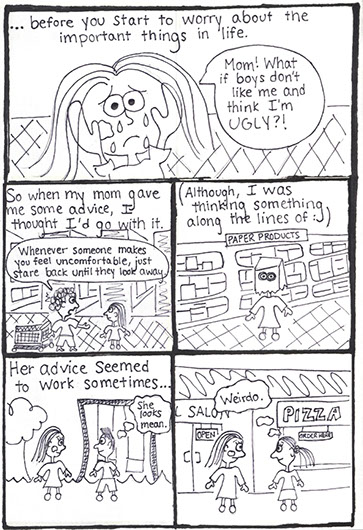“Do I look man enough?”
As someone whose body falls outside the societal ideal, I have struggled to establish a positive body image. Skinny, lithe, and lean, my body might fit the mold of a long-distance runner, but one would hardly consider it stereotypically masculine. One might even say it’s feminine. And if there’s one thing men are taught to reject, it is femininity.
I have spent years painstakingly overanalyzing nutrition and exercise and appearance, trying to decipher whether my body was a body I wanted, a body I felt proud of. I’ve tried to balance my daily miles with my daily calorie intake, a strong lower body with a comparatively weaker upper body. My exercise accomplishments —hikes, long runs, marathons, personal records—can sometimes feel less valuable when I consider my frame.
While trying to make sense of my body, I’ve grappled with the rigid definitions of masculinity and femininity: what constitutes a “good” body versus a “bad” body? The construction of these illusive categories show deep-rooted problems in the way society understands health, gender, and individual expression.
In the United States, the ideal male body is muscular, athletic, formidable, and toned. I don’t have bulging or sculpted muscles. I’m not tall or broad-shouldered. And for so long I focused on how my body failed to meet standards instead of defining my own terms for body satisfaction.
My time at college is marked by small steps forward in my journey towards establishing healthy body image. It has involved coming to terms with the ways in which my body does not meet the dominant standards of masculinity. This progress is largely due to students and faculty initiating conversations and posing important questions about body image and campus culture at Boston College and other campuses across the country.
While exploring my body image, I have grappled with questions like:
“Do I look man enough?”
“Do I look masculine?”
“Do I have a good body?”
“What is a good body anyway?”
What I’ve come to value—and what has helped so much—is having space to explore these questions with others, whether in class, at a lecture, or in a friend’s living room. So many people are exploring these questions!
June was Men’s Health Month, and advocates across the country created space for discussing issues like preventive health and mental health. After long being solely cast as women’s health issues, body image and body satisfaction have become increasingly vital topics
in men’s health as well. For instance, during Love Your Body Week at Boston College, there is always an event that addresses issues of masculinity and body image.
This chiseled ideal of masculinity narrows the range of male bodies deemed acceptable, attractive, or desirable and casts an impossible mold for men and boys. If you deviate too far from that standard, you might just feel out of place. For example, restricting the ideal body to an impossible healthy and muscular standard has produced an unhealthy culture of workout supplements and bodybuilding. The body is often a source of concern and dissatisfaction, and this kind of scrutiny can have debilitating consequences for mental and physical health, as in Body Dysmorphic Disorder and Muscle Dysmorphic Disorder.
Stories about body image are necessary because they reveal the cracks in the impossible model of embodied masculinity. Even starting these conversations can be difficult because stereotypical masculinity dictates that we show unwavering confidence in the face of adversity, that we hide vulnerability. Instead of engaging honestly and critically, we keep quiet.
Against the odds, while in college, I began to embrace my own body and celebrate the remarkable and beautiful diversity of all bodies. At college, we’re encouraged to examine the way our bodies affect our relationships with friends, classmates, partners, mentors, and professional connections. What’s less talked about is how this obsession with idealized bodies affects our relationships with ourselves.
Taking part in the campus conversations about body image and learning to celebrate difference provided the momentum I needed to move forward.
I had many difficult days and experiences, like runs not intended to celebrate my body but to punish it, restrictive eating habits, and experimenting with protein supplements. But I’ve come to focus less on how my body looks, and more on what it can do. I might have a slight frame, but my accomplishments are sizeable. I’ve raced two marathons and run countless miles. I’ve hiked difficult trails, culminating in the most spectacular views. I’ve become an adventurous eater, and I’ve embraced food as nourishment and cooking as an opportunity for building connections with friends and family.
Taking a holistic approach to body image—realizing that I am more than my body as much as I am my body—has helped me recognize the value and worth of my own frame. Instead of focusing on the stereotypically masculine features I don’t have, I focus on what I do have: an agile body that supports my everyday activities, an efficient and powerful stride that powers my long distance running.
I’m only one man, but this body is man enough for me.
Christopher Kabacinski is a recent graduate of Boston College, where he studied English and medical humanities, co-founded the Medical Humanities Journal of Boston College, and led the public speaking and storytelling group Word of Mouth. Originally from Scranton, Pennsylvania, Chris now lives in Boston and works in global public health.







































